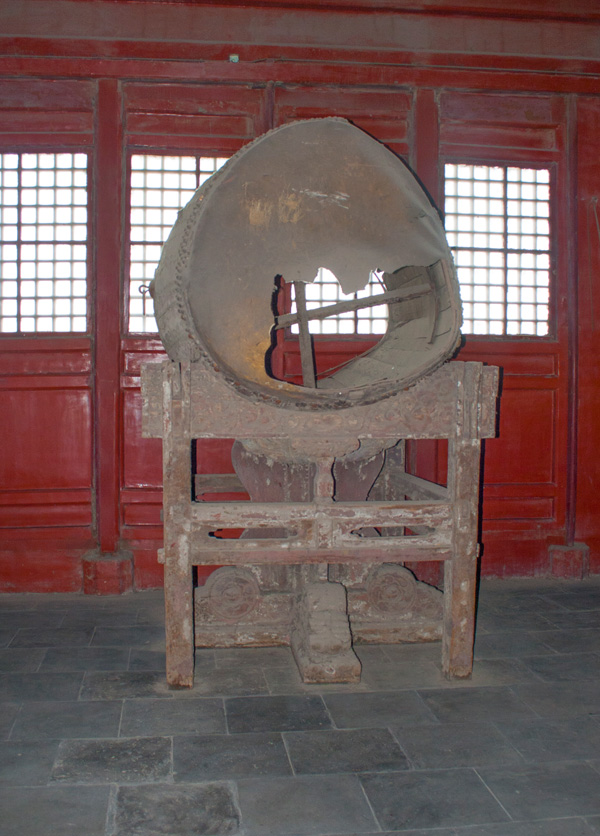
| The grandiose Drum Tower, with the Bell Tower in the background. [Photo: CRIENGLISH.com/William Wang] |
Every day, the Gulou area is abuzz with trendy young folks who flock there to buy kitschy-cute trinkets, test out electric guitars, sit in modish cafes, or catch rock concerts. Gulou translates to "drum tower", one of the landmark buildings that anchors the neighborhood. But ask around, and you'll find that only the tiniest fraction of people there have actually entered either the drum or bell tower for which the area is known. The two buildings are both situated on Beijing's central north-south axis, sandwiched in between Tiananmen, the Forbidden City and Jingshan Park to the south, and the Olympic Village to the north. The drum tower is the fatter building, whose red paint makes it look as if it were renovated yesterday. The bell tower on the opposite side of the courtyard lays bare its naked stones, its taut figure drawing the eye up toward the shadows to where the bell is concealed. Both towers introduce themselves with a long steep staircase, and offer enlightening perspectives on the city and the surrounding historic hutong alleyways. In 1272 the drum tower was erected at the center of Yuan Dadu, the capital of Kublai Khan, before moving to its present location just 142 years later. It's a tad more entertaining than its partner building, as perched high up on its second floor, a collection of huge dagu drums are on display, including the last surviving drum from a collection of 24 originals. The rest are replicas which are still functional and used. Every day seven drum performances are held, where five or so drummers raise their sticks to the heavens to bang out dramatic pieces for visitors. The building was originally intended for administrative purposes, but was later relegated to timekeeping duties. Five times a night, the drums would sound to signify dog hour (dusk), pig hour, rat hour, ox hour and tiger hour (a very early 5 a.m.). Apparently, sleeping on schedule was regarded as a crucial part of daily life. Still impressive today, the building was once a beacon of Peking. Unfortunately, only the southern balcony is open to the public, but its views still help put Beijing into perspective. The drums tolled the hour until 1924, when technology finally deemed them obsolete. The tower also houses a thought-provoking exhibition of ancient timekeeping devices featuring everything from incense sticks to water urns used to account for time passed, some of which are beautifully crafted by artisans. The bell tower, just meters away, allegedly holds the largest and heaviest bell in China, which weighs in at 63 tons. Legend has it that the remains of Lady Hua Xian are tempered into the copper ore of the bell. To save her father, who was crafting the bell for an impatient emperor, Lady Hua Xian sacrificed herself by jumping into the molten copper to ensure a successful casting. Lady Hua Xian would be happy to know that the bell's evening chime could be heard 20 distant kilometers away. Free tours (in English) take place several times a day. Otherwise, visitors can just take in the placards and views, descend back down the stairs, and reenter the Gulou scenester scene. Drum Tower entrance fee: 20 yuan Bell Tower entrance fee: 15 yuan 
The Drum Tower has seven drum performances daily. [Photo: CRIENGLISH.com/William Wang] 
A large collection of drums, newer and older, at the Drum Tower. [Photo: CRIENGLISH.com/William Wang] 
The last original drum in the Drum Tower. [Photo: CRIENGLISH.com/William Wang] 
The Bell Tower, as seen from the Drum Tower, across the courtyard. [Photo: CRIENGLISH.com/William Wang] 
The steep staircase of the Bell Tower. [Photo: CRIENGLISH.com/William Wang] |